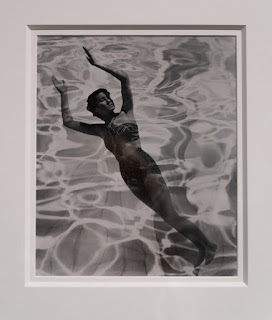 |
| Dora Maar |
Born in 1907 to Croatian father and a French mother she was christened Henriette Markovitch - however they both quickly obliged her request to be known as Dora. In 1931 she officially changed her professional name to Dora Maar—a shortening of Markovitch
Dora established herself as a professional photographer, although she was initially a painter, but decided photography was possibly more lucid than trying to sell paintings. Either way both are art forms where she certainly experimented and brought such interesting subjects to light.
 |
| Dora Maar painting |
Dora had a natural talent of bringing aesthetic to what could be considered dull and boring subjects. Her use of light was enough to bring depth to a flat photograph, using shadows and reflections that transformed a person to become enshrouded in an air of romance and mystery.
 |
| Model in evening gown and jacket |
 |
| Study of beauty |
 |
| Model in swimsuit |
 |
| Jacques Heim green velvet and white satin evening dress |
Dora experimented with surrealism and produced some interesting, but in my personal view some bizarre photography. I'm not a huge fan of surrealism, but using juxtaposition of images I found her work encouraged me to really look at something more deeply. It spurred me to think more about what was going on in her head and to consider the subject matter more, then just casually glancing at it.
Surrealism was indeed used by many to explore the imagination, the unconscious and dreams, so thank you André Breton, a poet that founded this form of art and one that I am looking at more closely.
Surrealism was indeed used by many to explore the imagination, the unconscious and dreams, so thank you André Breton, a poet that founded this form of art and one that I am looking at more closely.
 |
| Cavalier 1936 |
There were two photos that caught my eye; the chess piece called Cavalier and Monster on the beach.
Cavalier
Picasso and Dora met in 1935, but he left her 9 years later for Françoise Gilot and Dora suffered a breakdown and never recovered from this.
Monster on the beach
I feel this is a poignant title, but again does it symbol sadness of not being able to reach out and explore the sea or other lands. No feet to paddle and no wings to fly. Was this Dora's subconscious mind telling the world how she felt at the time? From the literature explored she was involved with the Surrealist movement that had strong political commitments, so was she influenced by them or were they influenced by her?
Dora was part of an ultra-leftist association called “Masses" and I have establish Dora created the "Monster on the beach" as part of the series of photomontages to explore anxieties surrounding the crumbling political climate and threat of World war II.
In fact photomontages were used by many to express political dissent.
 |
| The monster on the beach 1936 |
rue d'Astorg
 |
| 29 rue d'Astorg |
The rue d' Astorg photo literally drew me in and I kept going back to it time and time again. I still do. I was fascinated on how she was able to achieve the fish eye effect. I soon discovered that this was created by the influence of photomontage, but using a layering method. The deformed building effect was created from the curve of the cardboard on which it was printed on.
It is aptly called 29 rue d'Astorg, since she told her father she needed a studio to work from, otherwise she would have to join a commercial business. So, he obliged and payed the rent for an apartment at 29 rue d'Astorg - why she named this work after the apartment and why she used a heavy limbed figurine is a bit of mystery to me and perhaps I need to do some more digging to establish why.
 |
| rue d'Astorg - Forest 19 |
Dora experimented with different backgrounds using this figurine, here she uses a forest background, but to me it does not work, there is no story for me. The picture looks flat and uninteresting.
Advertising
Dora was very successful professional photographer and had an eye for the unusual and this final photograph is no exception. Here she has taken a spiders web and placed it over the face of Nusch. There could be many interpretations on what this could represent, such as a person spinning a web of lies, or someone feeling trapped.
Actually it was in fact for an advertising image for a face cream called, dispiritingly; The Years Lie in Wait for You.
 |
| Spiders webb |
 |
| Nusch Éluard |
 |
| The years lie in wait for you. |
The late Dora Maar was a talented photographer and artist and yet very little is known about her, there is so much about her life that is fascinating and intriguing. Such as her relationship with Picasso, and the well known portrait that Picasso painted called the weeping woman. Her passion for street and portrait photography, her fascination with photomontage and surrealism. I adore this quote from her in when she took up abstract photography instead of going back to capture real life.
'"The street has changed so much, don’t you think? It’s more extravagant … but at the same time it’s not interesting anymore, it’s banal"
Dora passed away on July 16, 1997 aged 89, she was and still is a fascinating and talented artist in every sense of the word. Sadly her work is now only being discovered.
 |
| The weeping woman |
Bibliography
Amao D, Maddox A, Ziebinska-Lewandowska (2019) Dora Maar. London: Tate Publishing
Baring L (ND) Dora Maar Paris in the time of Man ray, Jean Cocteau and Piscasso. New York: Rizzoli
No comments:
Post a Comment